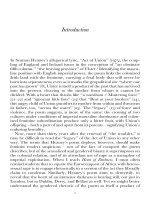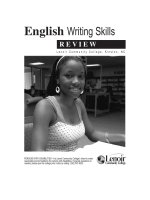English Writing Skills pptx
Bạn đang xem bản rút gọn của tài liệu. Xem và tải ngay bản đầy đủ của tài liệu tại đây (1.17 MB, 47 trang )
English Writing Skills
張森林教授
台大財金系
General Guidance
1. When writing a paper, you should
– Make sure you have a contribution
– State it explicitly and clearly
– Make connection with related literature
– Follow conventional styles
– Aim for a high level of presentation
– Use clear English
– Do not make papers too long
– Do not use unedited thesis material
Useful Tips
2. It may be useful to
– Prepare a folder (e.g. a collection of most relevant
papers) for a research project
– Establish your own list of widely used terminology,
notation, phrases, etc.
– Use Endnotes to edit the references
– Copy and adjust the sentences of well written papers
Introduction
3. Devote half the writing time to the introduction
and conclusion
– Once the ideas of a publishable paper are roughly
formulated, writing should be done within a month.
Otherwise, you lose interest. You may even forget
about the entire paper.
– About half of your writing time should be devoted to
writing the main body of the paper, which should be
done first.
– The remainder of your effort should be devoted to
writing the introduction and conclusion.
Introduction (cont.)
4. Get their attention early
– Provide evidence of why it is interesting (i.e., why it
should be published) in the introduction.
– If an apple does not taste good at the first bite, one
simply throws it away without giving any thought on
the nutritional value hidden in the apple.
– Likewise, most referees make up their mind at the first
bite, i.e., within 15 minutes of reading a paper.
– If the referees don't like a paper, they begin to look for
reasons to justify why the paper should be rejected.
Introduction (cont.)
– If the referee loses interest from reading the
introduction, he/she might postpone reading the
paper.
– If a paper is set aside, it could be several months later
when the referee picks up the paper again, probably if
and when he/she receives a reminder about the
review. This is one of the major reasons why it takes
a long time to get a report.
– Do not repeat the concluding remarks in the
introduction.
Introduction (cont.)
5. The introduction should be two pages or less
– If the introduction is more than two pages, it is too
long.
– Shorten it to 2 pages or 1/6 of the paper, whichever is
less.
– If you write more than two pages, then either
• you are discoursing a lot about other people, in which
case you are sending a signal that your contribution is
minor, relative to the literature, or
• you are discussing too many technical details, which do
not belong in the introduction.
Introduction (cont.)
6. Discuss real world examples
– Pass the relevance test by providing citations,
statistics, or anecdotes of real world examples.
– Then the referee cannot say the paper is
uninteresting, the most common reason for rejection.
– If the referee says it is not interesting, it is a value
judgment and there is no appeal! No editors will
publish an uninteresting paper.
– One important purpose of the introduction is to
prevent the referees from making that disparaging
remark.
Introduction (cont.)
– Without this sound footing in the real world, your
paper may give the impression to readers that it
provides a profound solution to nonexistent problems.
7. Imitate skillful writers
– Observe how other successful writers introduce their
topic, cite literature, and get on with their task.
– Imitate their words and phrases, and modify them to
suit your purpose.
– It is easier to imitate what someone else has written
than to create a totally new paragraph.
Introduction (cont.)
8. Do not plagiarize
– The word “plagiarize” means to “steal and pass off as
one’s own (the ideas or words of another).”
(Webster’s Third International Dictionary, 1986)
– Remember Robert Fulghum’s advice “Don’t take
things that aren’t yours.”
– If you do, you will pay dearly later when your work is
published. You are lucky if the paper is not published!
– If you are quoting statements made by another writer,
use identifying quotation marks.
Introduction (cont.)
– Some people suggest that one should not copy more
than three consecutive words without identifying
quotation marks. This is extreme advice that no one
can follow.
– Do not copy, but summarize the contributions of other
writers in your own words to the extent that they are
related to the subject of your paper.
– Mention the cited author with year of publication in the
text and give the exact source in the reference
section.
Introduction (cont.)
9. Do not use I
– Some authors do get away with I.
– Referees are generally biased against egocentric
persons.
– Take the writing task seriously, not yourself.
– “The paper achieves ” sounds softer and more
humble than “I did this.”
– Avoid starting a paragraph with I.
Introduction (cont.)
10. Create a packet of related articles for each
paper
– All cited and other related papers must be at hand.
– This practice saves time, especially when writing the
introduction and conclusion, and when you revise the
paper.
– If you maintain the background packet, you do not
have to go to the library every time you revise the
paper.
Introduction (cont.)
11.Treat others generously
– Emphasize the importance of the paper being written,
but not at the expense of others. They are probably
your referees and they are sensitive.
– Don’t hit people (Robert Fulghum). Do not hurt their
feelings.
– When mentioning the works of other persons, avoid
using negative terms.
– Examples:
• "The deficiency of Smith's approach is ”
• "The problems of these papers “
– Papers that attack others are likely to be rejected,
especially when the authors or their friends become
your referees.
Introduction (cont.)
12. Avoid predominantly citing your own works
– The referees may think you are a self-centered clod.
There are others who have contributed to the
literature.
– If the first page only mentions your past work, and not
that of others, it means either
• you are probably digging into an area in which no one
else is interested—this implication is bad—or
• you are an egotist who disregards the contributions of
others, which is even worse.
Introduction (cont.)
13.Cite the papers of potential referees in the
introduction
– In many situations, whether your paper is accepted or
not primarily depends on who referees it.
– If you offend the referee by your thoughtless
comments, this paper and many of your future papers
will have no place to go.
– Important references should be mentioned in the first
page.
– Hopefully, the editor will read the first page (or the
next) when choosing the referees.
Introduction (cont.)
– The editor may choose referees from those
mentioned in the introduction and references.
– Works of potential referees should be mentioned in
the introduction, rather than buried deep in footnotes
or the main body.
14.Give (accurate) credit generously to the most
likely referees
– Be generous to all authors cited, but particularly to
those who are likely to be referees.
– Explain why their works are significant for your
analysis.
Introduction (cont.)
– Write one or two sentences about the contributions of
each of the most likely referees and how their works
are related to yours.
– This takes up less than 1% of the space, but it can
affect the probability of acceptance significantly.
15.Find quotations from well-known authors
– This strategy increases the credibility of the paper.
– For instance, if John Maynard Keynes or Kenneth
Arrow said something about the topic, it is difficult for
the referee to argue that your paper is uninteresting.
Introduction (cont.)
– Quoting a live, famous person is more effective; his or
her students might be referees.
– Do not quote dead people too often; they won't be
your referees. (No pun intended.)
– Do not quote yourself. This implies narcissism or lack
of exposure to the thinking of other economists.
16.Do not be apologetic
– You may acknowledge the limitations of the approach
only once in the conclusion.
– But do not apologize for what the paper cannot do.
– The more you mention to the referees what the paper
does not do, the less contribution it seems to make to
the literature.
Preparing the Main Body
17. Prepare a rough outline before writing
– Sketch briefly the content of each section. Then
generate the text. Smooth out the connections.
Without this rough blueprint, the paper often evolves
in a different direction than you intended.
– This blueprint reduces the chances that you will lose
direction and dwell too much upon minor points.
– This sketch needs to be changed as you go.
Preparing the Main Body (cont.)
18.Start writing before the paper is finished in your
head
– The precise connection of words from beginning to
end cannot be done in your head, except by a few
geniuses like Shakespeare.
– A 15-page paper may contain about 4 - 5,000 words.
Writing a paper is like stringing pearls to make a
necklace. There is an optimum order for these pearls
to form a paper, and some pearls are better left out.
– Begin the main body of the paper with empirical or
theoretical results. Then create the introduction and
conclusion.
– Tables and references may be added as needed.
Preparing the Main Body (cont.)
19.Do not read too much
– Do not read too much before you begin to write. It can
interfere with your own thinking and writing.
– Imagine how much time a prolific writer would spend
reading the contributions of other people.
– It is impossible to read every paper ever written on a
subject.
– Remember your goal is to write and publish a paper,
not to read everything.
– You have other important things to do (e.g., taking
care of spouse and children)!
Preparing the Main Body (cont.)
– If your family is neglected, what good is your paper?
– If you read a dozen papers on a topic, you should
have enough material to write a paper. Now add
your own ideas to this base of knowledge.
20.Develop consistent and simple notations
– Invest enough time to design efficient notations for
your papers.
– Do this not just for one paper, but for most of your
papers. This helps you remember when you revise a
paper.
– If the notations are confusing, the paper cannot be
very illuminating.
Preparing the Main Body (cont.)
– Each paper may have some notations that are
specifically tailored for the task. But the variables
should come from a well-designed and consistent
set of notations so that you may readily remember
what they stand for.
21. Strike a balance between theory and
applications
– A theoretical paper should say something about
policies, applications, or empirical work.
– An empirical paper should say something about the
theory that led to the empirical work.
– Check the preferences of the journals that you are
considering.
Preparing the Main Body (cont.)
22.Divide long paragraphs
– If there are two or more ideas in a single paragraph,
split them up.
– Break up long paragraphs even if they contain a
single idea.
– Readers tend to skip long paragraphs. They
discourage referees and readers from reading the
paper.
– The eyes of readers are subconsciously looking for
open space. This is why important equations should
be displayed, rather than buried in the text.
– No paragraph should be longer than half a page.
– As a general rule, a paragraph should have more
than two sentences.









